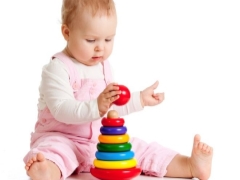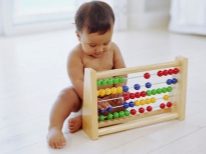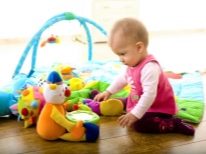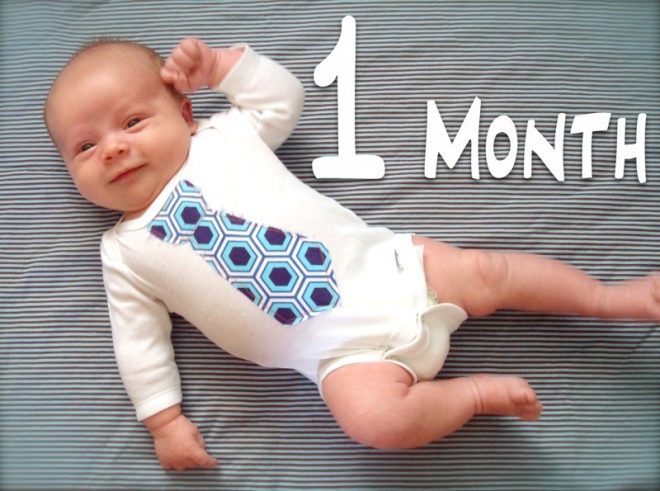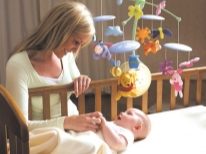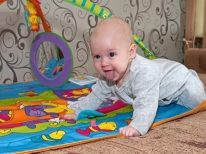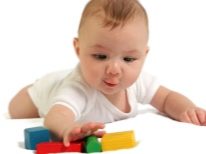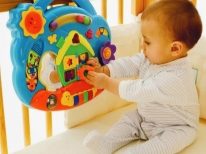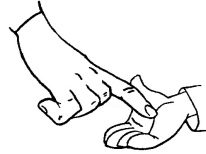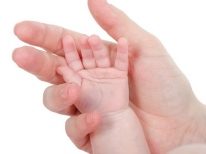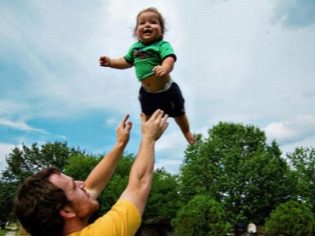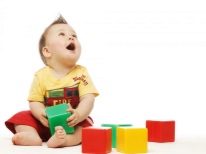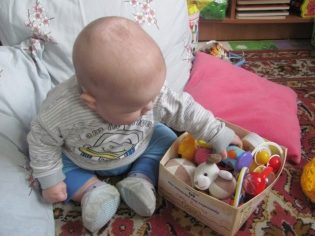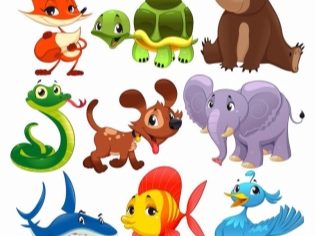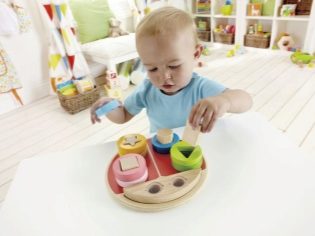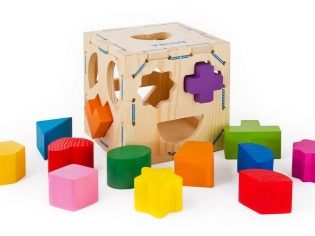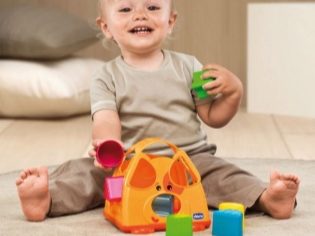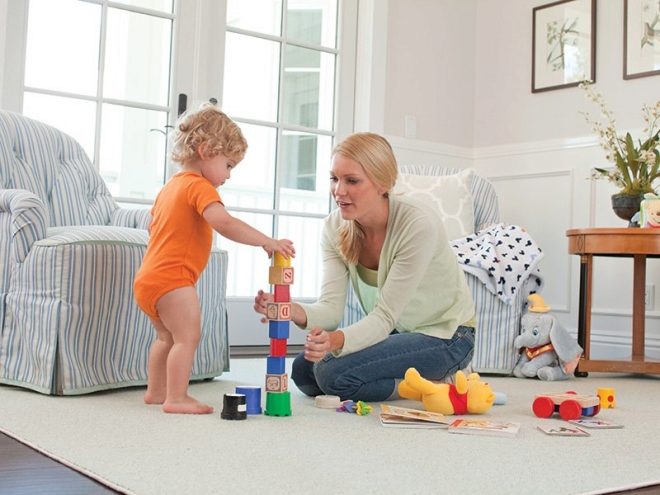Educational games for children up to a year.
From birth to one year, a child goes a long way in his development: from a helpless crumb, he quickly turns into a clever and curious toddler, who needs new impressions, emotions and knowledge along with food, water and love of parents. If parents pay due attention to the development of their baby, he will grow more harmonious, balanced, happy. In this article we will introduce you to educational games for children who are not yet a year old.
1 month
At this age, the sense organs are actively “tuned” in the baby. Therefore, developmental activities should be based on tactile sensations - the only way that the child can understand the world.
Stroking him often, talk to him. See clearly toys the baby cannot yet, but for a few seconds his gaze focuses on something specific: basically the toddler is trying to see his mother's face. This is still the most interesting thing for him. So build "conversations" on changing facial expressions, smiles.
2 months
Now the baby is able to hold the head, lying on his stomach, to focus his eyes on a bright toy for a moment, he is trying to turn the head to the left and right. Educational games for this age are aimed at training the view - move the toy slowly in the face of a child at a distance of 35-40 centimeters. This will allow him to learn to follow objects.
With a rattle slightly ring first to the right of the crumbs, then to the left - this will develop his ear.
3 months
At this age, the child begins to communicate emotionally. There are first attempts to roar, he finds out mom, dad, smiles. Build developmental activities on the development of the emotional sphere. Recite verses to him with expression, and at the same time try to intonate the voice as vividly as possible.
Koshkina counting
One, two, three, four, five,
The cat wants to count.
Because it is a little bit
Adds a cat to the mouse.
She has this answer -
There is a cat, but there is no mouse!
Child count
One, two, three, four, five,
My baby will go for a walk.
Very soon my baby
Will stomp on the track.
My dear friend is growing up -
It counts all around!
From this age it is very useful to listen to soft, pleasant music for a quarter of an hour, and also surely sing your songs to the kid, even if nature has not given the perfect musical ear and voice.
4 months
A child at this age is very inquisitive. He already knows how to grab items and even tries to drag them into his mouth. Build developmental activities with your son or daughter on the development of tactile sensations. Give him different pieces of fabric (silk, chintz, satin, velveteen), the baby will be happy to touch them, learning new sensations in his fingers.
On a strong thread or elastic can be strung large bright beads, buttons. This "garland" should be hung in the immediate vicinity of the crumbs, so that he could reach out and touch the objects with his hands. Many kids are enthusiastic about picking up round, flat and embossed objects.
5 months
The kid is very mobile, he is already well tossing and turning from side to side, some trying to sit. Movement - this is what now takes the baby most. Build educational games on simple physical exercises, during which you will be able to read already well-known poems and sing songs. For example, the game “Let's go-go” is well suited for this age:
Mom lies on the sofa on her back, puts the child on her stomach in such a way that her back rests on her bent legs:
We went - went to the forest for nuts!
On the bumps, on the trails, on the little penechki!
Suddenly, a fossa, Kohl (Petya, Dima, Olya, Lena, etc.) fell into the hole of the whip!
In this case, the mother spreads her legs slightly, holding the baby by the handles, so the support in the back area disappears from the crumbs. For a few seconds, without releasing his hands, you can lower him down and lift him again.
Talk more to the child: now he is actively forming the so-called inner speech - he cannot say so far, but he already remembers how it should sound. Show your child different things often and call them loudly and clearly. Encourage babble, now is the time to move from guilty to emotional babble.
From 6 to 12 months
Starting from six months, it is desirable to engage with the child every day, because now not only his body, but also the brain, its various departments are rapidly developing. That is why the existing developmental techniques imply not only classes aimed at the development of individual skills. It is preferable to choose the game, which will be a combination of different cognitive processes.
The best games were known even by our grandmothers and great-grandmothers, modern psychologists and children's teachers complemented them with their developments. It turned out quite an impressive list of developmental exercises and games, part of which we will try to cover in a little more detail:
- "Hide and Seek." This game develops the emotional sphere of the child, short-term memory, reaction. After a year or two, the baby will be happy to run and hide for real, but for now mother can imitate the disappearance process. It is enough to cover your face with your hands and say: “Where is my baby?”, And then open your palms, smile and answer yourself: “Here he is!”.
Such simple fun causes strong positive emotions in most children, crumbs liven up, they like to play mini hide-and-seek. At 8-9 months, you can show the child a toy, and then hide it somewhere near, so that the baby can see where. And so together with her "look for".
- "Magpie". This game, known to us all from childhood, develops fine motor skills, coordination, imagination and speech of the baby. Use the index finger of one hand to move the palm of the other in a circular motion:
Thieves, cooked porridge,
I fed babies ...
And then start bending the fingers on the hand on which the porridge was boiled:
This gave, this gave,
This gave and this gave.
And this (pointing to the little finger) - did not get it.
Then the fingers need to start unbending one by one in reverse order:
You wore water, you chopped wood,
You served the croup, you interfered with a spoon,
And you, the smallest, did not help!
Usually it is enough just a few times to show the baby this fun game, and he begins to repeat movements himself after the mother.
If this does not happen, you can help the crumbs, took his hands in his, and showing how it is done.
- "A brave pilot." Good old "flew-flew" has always been the best way to distract a child from the vagaries and bad mood. But for this game, it is best to invite dad or grandfather, because babies after 6-7 months already weigh enough to make it hard for mom to lift them with arms extended above their heads. The essence of the game is quite simple - the child must be raised horizontally, placing a hand under the breast, and imitate the sound of a flying plane. This game perfectly trains the vestibular apparatus of the child, gives him the opportunity to look at the world around him from a great height for him.
- "Building a house". If the child sits well and confidently crawls, you need to scatter bright cubes on the floor (without sharp corners), better plastic. The task of the child is to get to the cube, take it and give it to the mother, who will build a house or a tower from the elements collected by the child. This is not only an excellent physical training, but the development of logic, imagination, coordination of movements. Every successful attempt to take "building materials" should be praised emotionally, then the process will be a real pleasure for the kid.
- "Ladushki." One of the best games of many generations: even our great-grandmothers without the advice of teachers and psychologists have guessed that clapping her hands are very beneficial for the development of motor skills, coherence of movements, reaction and imagination. The actions are simple and available for babies of 6-8 months - you just need to clap:
Ladushki-palms, where were you? By Grandma!
What did you eat? Kashka, kashku-little one!
On the track grandmother baked pancakes!
Ate ate, flew home!
Next you need to start waving handles, as in flight:
Flew, flew, sat on the head!
Mom and baby raise their hands and lay on their heads.
- "Big and small." Give the child a big box (from the microwave, from daddy's shoes), fold smaller toys or objects into it and close the lid. The task of the baby - open, reach and fold back. The game can be complicated as a child grows up - hide one of the items so that the baby can understand what is missing in his box.
The game develops fine motor skills, logic, thinking, cognitive abilities, attention and memory. The main thing is to put your small items were not so small so that they can be swallowed. Suitable - a teaspoon, tangerine, a box from the ring, tea strainer, etc.
- "Who lives in the house?" For this game, you will need pictures that depict a variety of animals. They can be downloaded on the Internet and printed, or you can draw it yourself (if you can do it!). In a large tight envelope or box, fold the picture. During the game, get them out one by one, call the child naming the beast loudly and legibly (tiger, cat, elephant, bird, dog) and show what sounds this animal produces (cat meow, tiger -rrr , elephant-top-top, dog - gav-gav, etc.).
Gradually, the baby will be able to recognize animals and reproduce not only their sounds, but also the names of the animals themselves. This imitation is very useful for the development of speech skills, both internal speech and voice, for attention, stimulates the knowledge of the surrounding world.
- "Draw anything!". For such free-lance creativity, you will need a drawing paper, and preferably two large drawing paper glued together, and finger paints. Paints must be food, so that the crumb could paint and taste them without hearing any restrictions from mom. Spread sheets of paper on the floor, release the little artist on them and give a can of paint.
Such drawing stimulates thinking, develops creativity, coordination of movements. Little children can be engaged in finger-drawing for a rather long time and with enthusiasm.
- "Forms". For the development of logic and cognitive processes, the crumbs can be bought by special developmental designers, in which you need to place the corresponding figures in the base with cuts of different geometric shapes. It is possible to cut shapes with your own hands, from colored cardboard, and the basis for them can be made from white cardboard. The kid will be able to understand that the round - does not fit in the square, and the triangular does not push in the oval. Several times show the baby forms, call them, and then praise every time the pussy correctly selects a figure.
Tips for moms
In the desire to develop their child mothers should know when to stop. You should not offer your child games that are difficult to understand. He will quickly lose interest in them. All classes must be adapted for one or another age, and it will be correct to take into account the peculiarities of the development of your child. If the baby is not sitting at 6-7 months, it is not necessary to carry out games that involve sitting.
If the child lags behind the average standards a little, you should not expect the impossible from him.
The duration of classes should be increased in stages, so that the little tot will not get tired.
Classes are always desirable to hold at one time, pretty soon the baby will know that the game is coming, and will wait for it with impatience.
For developmental activities it is better to choose the time when the child is not tired, does not want to sleep, eat, walk.The optimal time is one hour before lunch (usually it is from 11 to 12 o'clock in the afternoon). In the evening, do not play before bedtime, so as not to perevozbodit kid. Familiar poems can simply read to him during the evening massage and swimming.
Be patient and consistent. More often praise the child, even if he still does not work. After all, developmental activities are also a great way to establish close contact between a child and parents.
An example of educational games you will learn from the following video.
